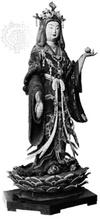- Fujiwara style
-
The style of the principal icons accorded with the emotional appeal of Pure Land Buddhism, introduced to counter the older esoteric sects. The sculpted figures, though still full and fleshy, were more elegant and heavily polychromed, with elaborate cut-gold (kirikane) patterns in the drapery. The facial type was aristocratic. Delicacy of expression was achieved by a joined-wood technique invented by Jōchō. Interest in decorative effects can be seen in the applied jewelry, which in earlier periods had been painted or modeled on the sculpture's surface.
 Kichijō-ten (Sanskrit Mahasri; the goddess of good luck) polychrome wood sculpture, Fujiwara ...Asuka-en, Japan
Kichijō-ten (Sanskrit Mahasri; the goddess of good luck) polychrome wood sculpture, Fujiwara ...Asuka-en, Japan* * *
▪ Japanese sculptureJapanese sculptural style of the Late Heian period (897–1185), known also as the Fujiwara period. Although many sculptures at the beginning of the period are in essence continuations of the Jōgan style, by the middle of the period a radical change had occurred in the style of the principal icons. This was partly the effect of the advent of the new Jōdō sect of Buddhism, which relied more upon emotional appeal than did the older esoteric sects; one needed simply to adore Amida to be saved.The sculpted figures were still full and fleshy, but they were also more elegant and appeared to be lighter in weight. There is a complete use of polychrome, with an elaborate development of cut-gold, or kirikane, patterns on the draperies. The softness of modelling, quite unlike the powerful forms of earlier periods, is the result of a joined-wood technique invented by the sculptor Jōchō, which allowed the sculptor greater freedom and delicacy of expression. The facial type is aristocratic, almost effeminate, with a small rosebud mouth, high arching eyes, and a narrow, short, sharp nose. Remnants of older traditions persisted in this style, but these were overlaid by the new Fujiwara interest in decorative effect that is seen especially in the applied jewelry, which in earlier periods had been painted or modelled on the surface of the sculpture.* * *
Universalium. 2010.
